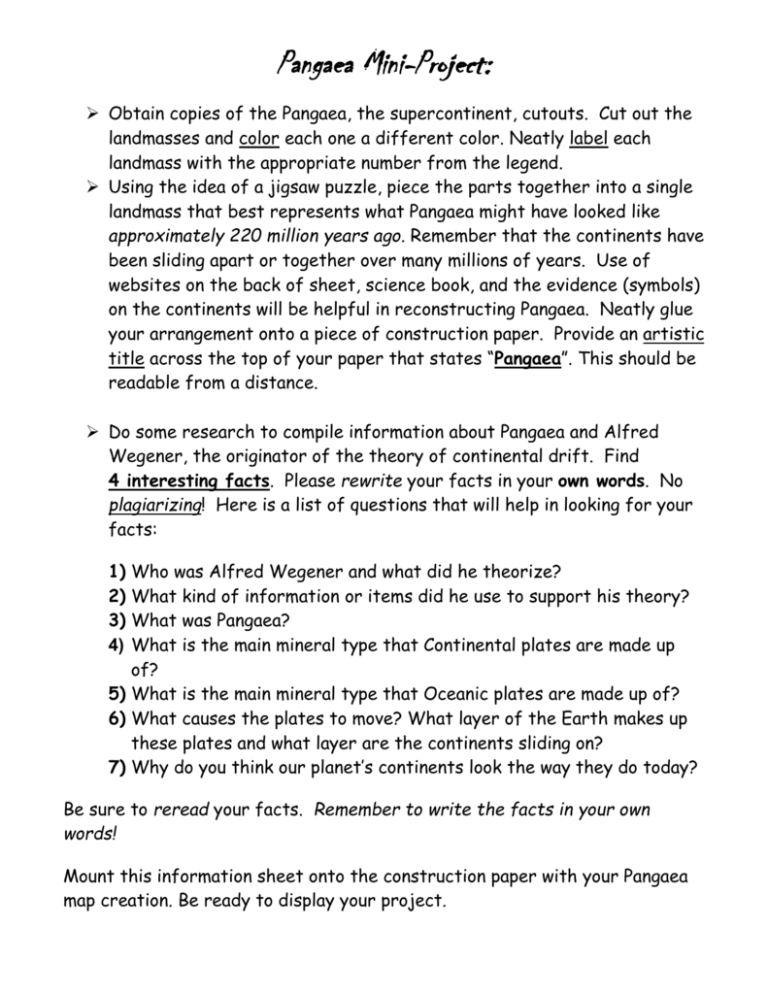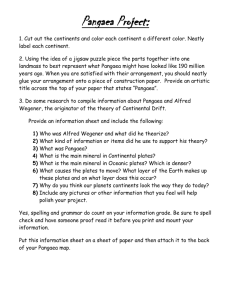Pangea Project:
advertisement

Pangaea Mini-Project: Obtain copies of the Pangaea, the supercontinent, cutouts. Cut out the landmasses and color each one a different color. Neatly label each landmass with the appropriate number from the legend. Using the idea of a jigsaw puzzle, piece the parts together into a single landmass that best represents what Pangaea might have looked like approximately 220 million years ago. Remember that the continents have been sliding apart or together over many millions of years. Use of websites on the back of sheet, science book, and the evidence (symbols) on the continents will be helpful in reconstructing Pangaea. Neatly glue your arrangement onto a piece of construction paper. Provide an artistic title across the top of your paper that states “Pangaea”. This should be readable from a distance. Do some research to compile information about Pangaea and Alfred Wegener, the originator of the theory of continental drift. Find 4 interesting facts. Please rewrite your facts in your own words. No plagiarizing! Here is a list of questions that will help in looking for your facts: 1) 2) 3) 4) Who was Alfred Wegener and what did he theorize? What kind of information or items did he use to support his theory? What was Pangaea? What is the main mineral type that Continental plates are made up of? 5) What is the main mineral type that Oceanic plates are made up of? 6) What causes the plates to move? What layer of the Earth makes up these plates and what layer are the continents sliding on? 7) Why do you think our planet’s continents look the way they do today? Be sure to reread your facts. Remember to write the facts in your own words! Mount this information sheet onto the construction paper with your Pangaea map creation. Be ready to display your project. Helpful Research Links: Tectonic Plates and Alfred Wegener http://www.tqnyc.org/NYC040622/tectonicplates.html Alfred Wegener Biography http://www.ucmp.berkeley.edu/history/wegener.html Color-Coded Continents http://wrgis.wr.usgs.gov/docs/usgsnps/pltec/scplseqai.html What on Earth Is Plate Tectonics? http://wrgis.wr.usgs.gov/docs/usgsnps/pltec/pltec1.html Understanding Plate Motions http://pubs.usgs.gov/publications/text/understanding.html Plate Tectonics http://scign.jpl.nasa.gov/learn/plate.htm On the Move http://kids.earth.nasa.gov/archive/pangaea/ Discovering Plate Boundaries http://www.geophysics.rice.edu/plateboundary/TGpart1_notes.pdf This Dynamic Earth: The Story of Plate Tectonics http://pubs.usgs.gov/publications/text/dynamic.html











